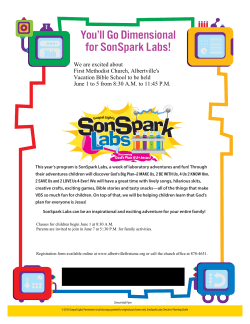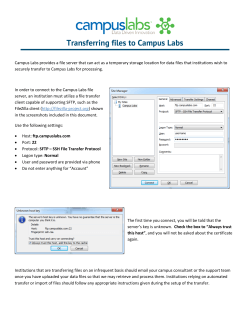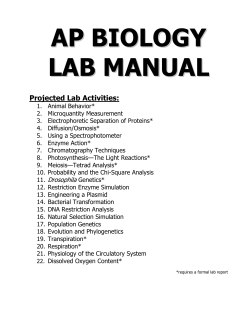
Book News - DeustoTech Learning
Book News Fernando A. Silva and Marian P. Kazmierkowski IT Innovative Practices in Secondary Schools: Remote Experiments By Olga Dziabenko and Javier GarcíaZubía (Eds), Engineering Collection series of the Deusto University Publications, Bilbao, Spain, 2013, softcover, 348 pages, ISBN: 978-84-15759-16-4. T he book IT Innovative Practices in Secondary Schools: Remote Experiments presents an overview of how to apply emerging and innovative technologies in industrial electronics teaching and learning processes. This book deals specifically with remote labs for secondary schools and was written by key researchers in cooperation with editors Olga Dziabenko and Javier García-Zubía from the DeustoTech Learning Research Group, University of Deusto. The publishing was supported by the Lifelong Learning Programme of the European Union project OLAREX: Open Learning Approach with Remote Experiments (518987-LLP-2011-ES-KA3-KA3MP). The editors apply information and communications technology (ICT) modern trends to education with an emphasis on secondary and primary levels. They promote the use of remote laboratories and experimentation for different topics and end-users through the WebLab-Deusto Digital Object Identifier 10.1109/MIE.2014.2388011 Date of publication: 19 March 2015 platform (http://www.weblab.deusto.es), which has been currently supporting students for more than a decade. The textbook brings together individuals and teams from a wide range of technology and education fields to look into the future and to share visions and ideas about the use of learning experiences and educational technologies in the science classroom of the future. It includes a rich collection of examples of futuristic scenarios. Extended pilot implementations are presented and discussed in detail. The text is divided in three main sections and 13 chapters. Section 1, “Transforming Education,” discusses the potential of innovative tools to change science education. The authors support that science classrooms should provide challenging, authentic learning experiences and more opportunities for students to participate in scientific practices and tasks, using the language of science and working with scientific models and tools. Section 1 contains the following chapters: ■■ Chapter 1: “Discover the COSMOS: e-infrastructures for an Engaging Science Classroom,” by Sofoklis A. Sotiriou and Angelos Lazoudis ■■ Chapter 2: “Technology Enhanced Learning: Challenge for Teachers and Schools,” by Elena Trepule˙, Margarita Teresevicˇiene˙, and Airina Volungevicˇiene˙ ■■ Chapter 3: “Scaffolding the Teaching and Learning of Science,” by Augusto Chioccariello ■■ Chapter 4: “Knowledge Transfer in School-Enterprise Cooperation of Vocational Education: Enhancing Students’ Self-Learning Ability 92 IEEE industrial electronics magazine ■ march 2015 for Employability,” by Luis Ochoa Siguencia, Katarzyna Kruszyn´ska, and Tomasz Paprocki ■■ Chapter 5: “Use of ICT in Bulgarian Schools and Museums,” by Ekaterina Tsekova and Svetozara Kararadeva. Section 2, “Engaging STEM in Secondary Schools with Remote Experiments,” presents four remote and virtual laboratories and their implementation in real school environments. The authors discuss processes and methodologies developed to integrate the proposed solutions in physics courses, mechanics, electricity, and electromagnetism. The authors show how remote labs can expand the capability of conventional labs by increasing the number of times and places where students can perform experiments. Moreover, the authors prove the potential of remote labs to provide affordable experimental data by sharing expensive laboratory equipment to a large number of students. Section 2 contains the following chapters: ■■ Chapter 6: “RRLab: Remote Reality Laboratory to Teach Mechanics in Schools,” by Elisa Cauhé, Alfredo Ferrer, Gonzalo Ruiz, David Íñiguez, and Alfonso Tarancón ■■ Chapter 7: “Using a VISIR Laboratory to Supplement Teaching and Learning Processes in Physics Courses in a Swedish Upper Secondary School,” by Lena Claesson, Imran Khan, Johan Zachrisson, Kristian Nilsson, Ingvar Gustavsson, and Lars Håkansson ■■ Chapter 8: “Virtual System in Reality (VISIR) in School Environments,” by Barbara Igelsböck, Arnulf May, Ramona Georgiana Oros, and Andreas Pester Chapter 9: “INTe-L: Wide Open Door for Education by Remote and Virtual Experiments Exemplified on Electricity, Magnetism, and Electromagnetism,” by Franz Schauer, Miroslava Ožvoldová, and Lukas Tkácˇ. Section 3, “Inspiring Education with Remote Experiments,” presents a series of more advanced applications that combine the use of remote labs and experiments with mobile applications, sensors, robotics, and serious games to introduce creative activities in the school classroom. A series of examples is given to show how remote experiments or simulations, combined with mobile devices in the framework of game-based approaches, can support science learning. Students will develop the “spirit of inquiry and research” if they are allowed to evolve their own research questions, choose suitable experimentation designs, and finally perform the experiment. The inquiry and research spirit is one important premise to develop original ideas. Section 3 contains the following chapters: ■■ Chapter 10: “Creativity@School: Mobile Learning Environments Involving Remote Labs and e-portfolios. A Conceptual Framework to Foster the Inquiring Mind in Secondary STEM Education,” by Claudius Terkowsky, Tobias Haertel, Emanuel Bielski, and Dominik May ■■ Chapter 11: “Mobile Remote Experimentation Applied to Education,” by Juarez Bento da Silva, Willian Rochadel, Roderval Marcelino, Vilson Gruber, and Simone Meister Sommer Bilessimo ■■ Chapter 12: “Remote Laboratory for Serious Games Deployment Based on a Mobile Robot Platform,” by Iñigo Iturrate, Ignacio Angulo, and Pablo Orduña ■■ Chapter 13: “Acquisition of Higherorder Experimental Skills Through Remote and Virtual Laboratories,” by Maria Teresa Restivo and Gustavo R. Alves. A preface by Sofoklis A. Sotiriou, an introduction by Olga Dziabenko and Javier García-Zubía, table of contents, and references (at the end of each chapter) are also included. ■■ This book contains well-documented proposals from an international group of specialists in the field of remote laboratories and in the integration of remote experimentation in the classroom. It can be a valuable tool for professors, engineers, technicians, and students, given its comprehensive treatment of the subjects and the known results of remote laboratories activity in the student lab competencies at the secondary school level. —Fernando A. Silva Object Detection and Recognition in Digital Images: Theory and Practice By Boguslaw Cyganek, Wiley-Blackwell, 1 ed., hardcover, 548 pages, July 2013, ISBN-10: 0470976373, ISBN-13: 978-0470976371. C omputer vision belongs to one of the most dynamically developing areas of computer science. Many developments of recent years, such as face and gesture recognition, pedestrian detection, and car tracking, resulted in new features embedded in consumer electronics, cars, mobile phones, as well as in more automatic assembly and production lines, and security and biometrics systems. All these became possible as a result of joined efforts of numerous scientists from different domains. However, such a dynamically growing area employing methods originating from diverse concepts and of a multidisciplinary nature pose a real challenge when it comes to understanding, especially for young researchers, students, and engineers. Books are used not only to convey knowledge but to present it in a way to make the learning process fast and successful. The book Object Detection and Recognition of Digital Images: Theo ry and Practice by Dr. Sc. Boguslaw Cyganek, published by Wiley, 2013, Digital Object Identifier 10.1109/MIE.2014.2388012 Date of publication: 19 March 2015 clearly meets these criteria. The goal of the author was to explain the concepts of modern computer vision methods, blending theory with practical examples. The detailed mathematical derivations contained in this book help in understanding the key concepts. Real-life examples, backed up by details of code implementations, help in bringing the theory to real applications. The book focuses on methods developed by the author over the past few years, with a majority of examples coming from the automotive industry. Some mathematical background, as well as basic programming skills, is expected from the reader. The book has more than 550 pages and consists of five main chapters and an appendix. After an introduction outlining the book contents, Chapter 2 is devoted to the tensor methods in computer vision. This is the largest chapter, with more than 170 pages, and by itself could be a separate book. It reflects a deep interest of the author in this group of very promising and sometimes surprisingly effective methods. Tensors, which have a long history in modern physics as entities to represent physical values in different coordinate systems, have been recently employed in such domains as chemistry, psychometrics, as well as in the computer vision. One needs to remember that tensors were employed in computer vision in various tasks, such as object representation with the inertia tensor, filtering of magnetic resonance images, local structure detection, and optical flow as well as multiple view representations with multifocal tensors and a multilinear representation and classification of visual patterns. The multilinear representation and classification of visual patterns received much attention in the chapter. This chapter will be of particular interest to researchers who are about to start, or already work in, the field of multilinear tensor methods for pattern recognition with any type of signals. We find very useful the case study sections exemplifying real-life computer vision applications, together with the C++ code, a part of march 2015 ■ IEEE industrial electronics magazine 93
© Copyright 2025


















